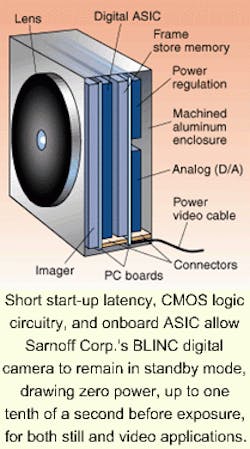Conference Review: AeroSense comes down to earth
ORLANDO, FL–Camera technology, from digital to infrared (IR), basically shrank in size for this year's AeroSense conference, held here April 25-27. Although it was billed as the 14th annual international symposium on aerospace/defense sensing, simulation, and controls by show sponsor SPIE (Bellingham, WA), the conference promoted lower-cost technology with diverse applications ranging from industrial inspection and preventive maintenance to fire fighting and pollution monitoring.
Sarnoff Corp. (Princeton, NJ), for example, introduced BLINC, a complete digital camera built around a CMOS sensor, for applications such as video and still imaging to covert surveillance, Internet imaging, and machine vision (see figure). According to Neil McCaffrey, head of Sarnoff's advanced imaging group, the 1.2 x 1-in. unit, which operates on a single 3.3-V power supply, provides digital and analog output at VGA resolution (640 x 480 pixels). The unit also goes from power-down to accurate image capture in less than a tenth of a second. "Other cameras are incapable of rendering details in a high-contrast scene," adds McCaffrey. "This system's 110-dB dynamic range allows it to deliver images with clear detail in both high-light and shadow areas. The results are natural-looking electronic images that more closely approximate photographic film."
Companies touting cost-conscious products at the event were able to do so by blending emerging technology with standard off-the-shelf components. Illustrating this key element was the Alpha miniature IR camera (Indigo Systems; Santa Barbara, CA) with focal-plane array and camera electronics packaged in an 8-in.3 volume, which can piggyback on top of a Sony minicam, feeding off its power and providing IR imaging through its onboard display. The miniature camera operates in the long-wavelength IR (7.5-13.5 µm) using uncooled microbolometer technology that makes it possible to use small low-cost optics with f numbers higher than 1.0. The standard lens for the system is a single-element germanium f/1.6 optic with an 11-mm focal length that provides a 40° x 30° field of view. Viewing options include analog video in monochrome RS-170A format, as well as real-time 12-bit-corrected digital video. Images are displayed at 30 frames/s.
Also demonstrating microbolometer-based uncooled IR camera technology was Raytheon Systems Co. (Dallas, TX). One of the firm's systems for untended ground-sensor applications has a front-end camera configuration comprising a 120 x 160-pixel wafer-level packaged focal-plane array, a 1-in. f/1 optics assembly, and a 2.5 x 4-in. surface-mount electronics board. The camera is operated by a digital signal processor (DSP) with flash program memory that is reprogrammable in the field. Its focal-plane array with flex-line attachment is thermally connected to the optics housing, with both operating at the ambient temperature. The temperature of both the array package and optics housing is measured but not controlled.
Helping control costs with the Raytheon system is the wafer-level packaging approach in which all arrays on a wafer are sealed in one step. In addition, the system's amorphous silicon (a-Si) makes a dc measurement of the detector resistance, which allows the camera to operate without a chopper. With proper calibration, it can make radiometric temperature measurements of each pixel within the calibration range. The DSP-controlled architecture also employs a commercial off-the-shelf DSP, A/D memory, and voltage regulator chips. The only custom component at this level is the detector chip.
Although IR technology seemed to dominate the exhibit floor, it didn't necessarily dominate the conference sessions at Aerosense. One of the best-attended technical clusters involved display technology, and the aerospace and defense industries accounted for a large segment of attendees. Overall, attendance at the conference and on the exhibit floor seemed as healthy, maybe even more so, than last year's event.
About the Author
Paula Noaker Powell
Senior Editor, Laser Focus World
Paula Noaker Powell was a senior editor for Laser Focus World.
